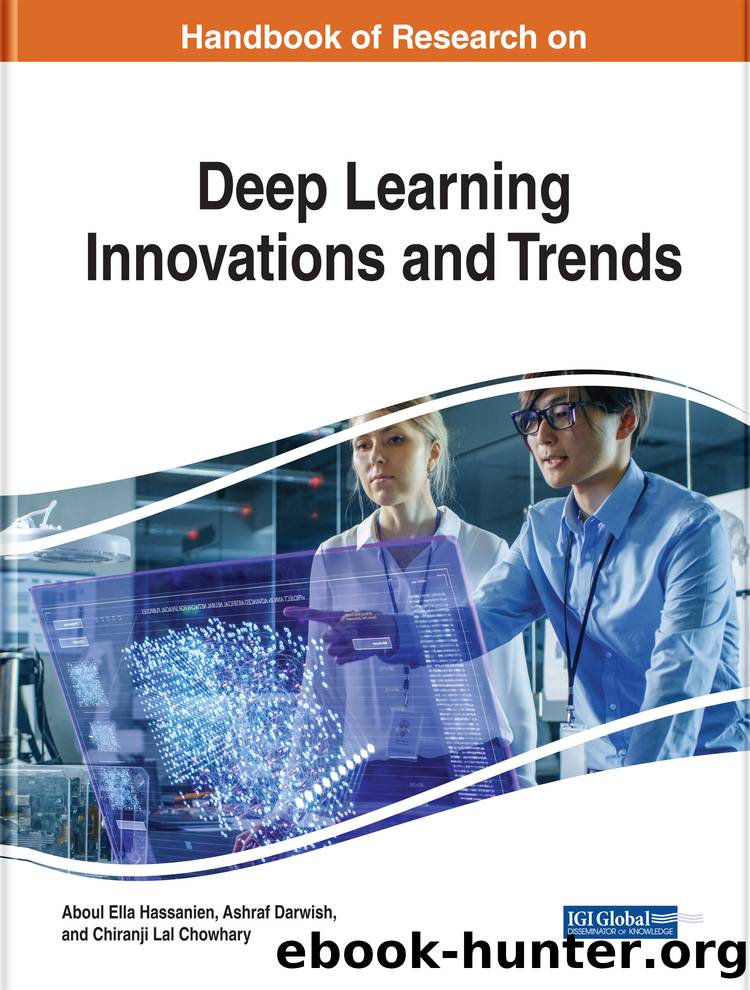Handbook of Research on Deep Learning Innovations and Trends by Hassanien Aboul Ella;Darwish Ashraf;Chowdhary Chiranji Lal;

Author:Hassanien, Aboul Ella;Darwish, Ashraf;Chowdhary, Chiranji Lal;
Language: eng
Format: epub
Publisher: IGI Global
Deep Learning is going to play a major role in near future in all field and area of research. It is predicted that in next five to ten years Deep Learning based tools, packages, libraries would become a standard component in every software applications. Some of the vital deep learning applications that will be predominant in 2018 and beyond are listed below.
1. Healthcare: Deep learning is extensively used in Breast or Skin Cancer diagnostics and also in prediction of personalized medicine on the basis of Biobank-data. Artificial Intelligence is completely reforming life sciences, medicine, and healthcare as an industry. Innovations in AI are succeeding the future medicine and population health management in incredible ways. Computer-aided detection, decision support tools, quantitative imaging, and computer-aided diagnosis will play a major role in years to come.
2. Voice Search and Voice-Activated Assistants: One of the most prevalent usage areas of deep learning is voice-activated intelligent assistants and voice search. Voice-activated assistants are present nearly in every smartphone. Apple’s Siri is one of the model which is on the market since October 2011. Google has launched voice-activated assistant for Android less than a year after Siri. Cortana is the newest voice-activated intelligent assistants by Microsoft.
3. Automatically Adding sounds to Silent Movies: The task of synthesizing the sound to match the silent video is an interesting task. The system is trained using 1000 examples of video with sound of a drumstick hitting various surfaces and creating diverse sounds. A deep learning model links the video frames with a database of pre-rerecorded sounds in order to select a sound to play that matches best with the scene. scene. The system is then evaluated using a turing-test like setup where humans had to determine which video is having the real or fake (synthesized) sounds. This uses application of both convolutional neural networks and Long short-term memory (LSTM) recurrent neural networks (RNN).
4. Automatic Machine Translation: The process of converting the words, phrases or sentence automatically from one language to another language is called Automatic Machine Translation. Deep learning has proved in these two specific areas:a. Automatic Translation of Text
b. Automatic Translation of Images
Download
This site does not store any files on its server. We only index and link to content provided by other sites. Please contact the content providers to delete copyright contents if any and email us, we'll remove relevant links or contents immediately.
Algorithms of the Intelligent Web by Haralambos Marmanis;Dmitry Babenko(8333)
Test-Driven Development with Java by Alan Mellor(7037)
Data Augmentation with Python by Duc Haba(6957)
Principles of Data Fabric by Sonia Mezzetta(6687)
Learn Blender Simulations the Right Way by Stephen Pearson(6603)
Microservices with Spring Boot 3 and Spring Cloud by Magnus Larsson(6458)
Hadoop in Practice by Alex Holmes(5979)
RPA Solution Architect's Handbook by Sachin Sahgal(5852)
Jquery UI in Action : Master the concepts Of Jquery UI: A Step By Step Approach by ANMOL GOYAL(5833)
The Infinite Retina by Robert Scoble Irena Cronin(5554)
Big Data Analysis with Python by Ivan Marin(5512)
Life 3.0: Being Human in the Age of Artificial Intelligence by Tegmark Max(5184)
Pretrain Vision and Large Language Models in Python by Emily Webber(4475)
Infrastructure as Code for Beginners by Russ McKendrick(4264)
Functional Programming in JavaScript by Mantyla Dan(4059)
The Age of Surveillance Capitalism by Shoshana Zuboff(3985)
WordPress Plugin Development Cookbook by Yannick Lefebvre(3971)
Embracing Microservices Design by Ovais Mehboob Ahmed Khan Nabil Siddiqui and Timothy Oleson(3774)
Applied Machine Learning for Healthcare and Life Sciences Using AWS by Ujjwal Ratan(3747)
